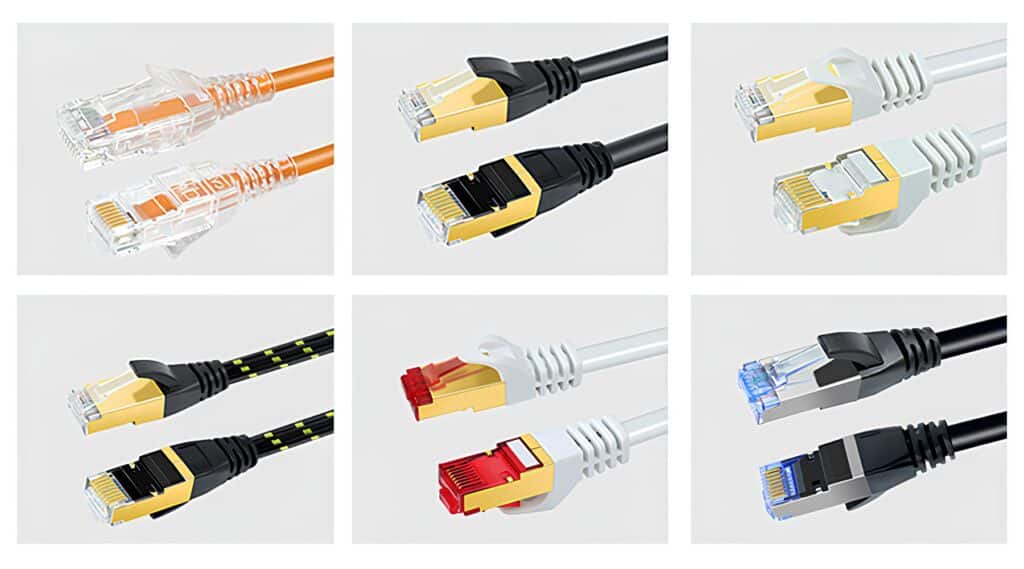
Ethernet cables are essential to the modern wired network. This backbone drives virtually all of our static digital communication today. Whether you are setting up a home network or are the engineer responsible for a corporation-wide network, you must know the types of Ethernet cables, their uses, and their specifications.
Understanding Ethernet: The Role of Connectivity in the Internet Age
Ethernet wiring uses carrier-sense multiple access with collision detection to control medium access and provide efficient transmissions on shared media such as the bus. It differs from Wi-Fi in that there are no physical conflicts (caused by multiple devices sending data at once) to get in your way; with Ethernet, everything works. And, unlike Wi-Fi, Ethernet uses actual cables, making it easier to see and check.
Types of Ethernet Cables
All Ethernet cables are not created equal. The cable comes in several categories, each boasting different performance levels.
| Ethernet Cable Types | Transmission Rate | Frequency Bandwidth | Transmission Distance | # of twisted pairs | Shielding |
|---|---|---|---|---|---|
| Cat-5e | 1000Mbps | 100MHz | 100M | 4 | Shielded/Unshielded |
| Cat-6 | 1000Mbps | 250MHz | 100M | 4 | Shielded/Unshielded |
| Category-6a | 10Gbps | 500MHz | 100M | 4 | Shielded/Unshielded |
| Cat-7 | 10Gbps | 600MHz | 100M | 4 | Double Shielded |
| Cat-8 | 40Gbps | 2000MHz | 30M | 4 | Double Shielded |
Popular Categories
- Cat-5e is a better version of Cat-55. It supports speeds of up to 1 Gbps and has better crosstalk immunity.
- Cat-6: Rated at 1 Gbps over long distances and 10 Gbps over short distances.
- Cat-6a: Offers twice the bandwidth of Cat-6 and can support up to 10 Gbps over 100 meters.
- Cat-7: Supports 10 Gbps speeds and is built with a proprietary design, not a standard.
- Cat-8: Ideal for data centers capable of having 40 Gbps bandwidth, but expensive.
Choosing the Right Ethernet Cable
Most families can get by with Cat-6 cabling, which is high bandwidth and performance. Specialists in this area would like to use Cat-7 or even Cat-8 cables for those higher speeds and more protection against interference, which is essential in high-demand environments, such as factories.
Key Components of an Ethernet Connection
- Ethernet Protocol: Governs the transmission of data between various components.
- Ethernet Port: Using RJ-45 connectors is standard.
- Ethernet Network Adapter: Allows computers to interface with local area networks (LANs).
- Ethernet Cable: Connects devices within a network.
Special Types of Ethernet Cables
Solid vs. Stranded
- Solid Cables: Better performance is used where the cable is to remain fixed.
- Stranded Cables: More flexible, used in home networks and by people on the move.
Crossover Cables
Used to connect two computers directly, with different wiring at each end. In the finished article, the tag on the side also makes it easier for network technicians to tell one kind from another at a glance.
How to Install and Some Considerations
Length and Gauge of the Cable
- Maximum length occurs at 100 meters.
- Larger gauge (AWG) conductors mean less resistance and better performance.
Jacket Ratings
- CM/CMG: General purpose.
- CMR: Riser for vertical spaces.
- CMP: Plenum is for spaces above/below floors with HVAC systems.
- CMX: Outdoor for exterior installations.
Shielding
- UTP: Unshielded.
- STP: Shielded.
- SSTP: Screened and shielded.
Power over Ethernet (PoE)
It allows power and data to be transmitted over a single cable, making it ideal for devices like security cameras and wireless access points.
Conclusion
Ethernet cables are essential for creating reliable, high-speed networks. By understanding the different types and choosing the right one for your needs, you can ensure optimal performance and connectivity for both home and business networks.
Looking for More Information?
If you need further help choosing the right Ethernet cable, Romtronic offers expert advice and a range of Ethernet cable assemblies that meet international standards.
The following Ethernet cable-assembly products are produced by our company and are offered for your reference.



Apple Liu is Romtronic’s Marketing Manager, focusing on business growth across the Asian market. With a background in International English and eight years of sales experience in the electronic cable and harness industry, she brings both in-depth industry knowledge and a global outlook to her role.
In addition to leading market strategy, Apple also oversees content development and editorial work—crafting clear, engaging messaging that reflects Romtronic’s values and technical strengths. She is passionate about digital engineering and is committed to strengthening Romtronic’s brand presence and innovation in a competitive global landscape.


